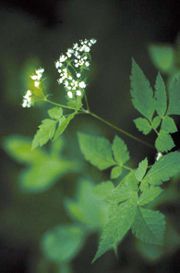Osmorhiza claytonii
| Osmorhiza claytonii subsp. var. | Sweet Cicely | |||||||||||||||||||||||||||||||||||||||||||||||||||||||
|---|---|---|---|---|---|---|---|---|---|---|---|---|---|---|---|---|---|---|---|---|---|---|---|---|---|---|---|---|---|---|---|---|---|---|---|---|---|---|---|---|---|---|---|---|---|---|---|---|---|---|---|---|---|---|---|---|

|
|
| ||||||||||||||||||||||||||||||||||||||||||||||||||||||
| ||||||||||||||||||||||||||||||||||||||||||||||||||||||||
Sweet Cicely (Osmorhiza claytonii) is a North American perennial herb.
The leaves are yellowish green. There are white hairs on the stem and to a lesser extent on the leaves as well. It is turnately branched, having either three leafed branches. When broken it has an anise like smell or flavor.
The seeds of this plant have barbs on the end allowing them to stick to clothing, fur, or feathers.
| Standard Cyclopedia of Horticulture |
|---|
|
Osmorhiza claytonii, Clarke (O. brevistylis, DC.). Rather stout, villous-pubescent: Lvs. 2-3-ternate: rays stout, 1-2 in. long: style and stylopodium half a line long. Canada to N.C.
|
Cultivation
Propagation
Pests and diseases
Varieties
Gallery
-
photo 1
-
photo 2
-
photo 3
References
- Standard Cyclopedia of Horticulture, by L. H. Bailey, MacMillan Co., 1963
External links
- w:Osmorhiza claytonii. Some of the material on this page may be from Wikipedia, under the Creative Commons license.
- Osmorhiza claytonii QR Code (Size 50, 100, 200, 500)
